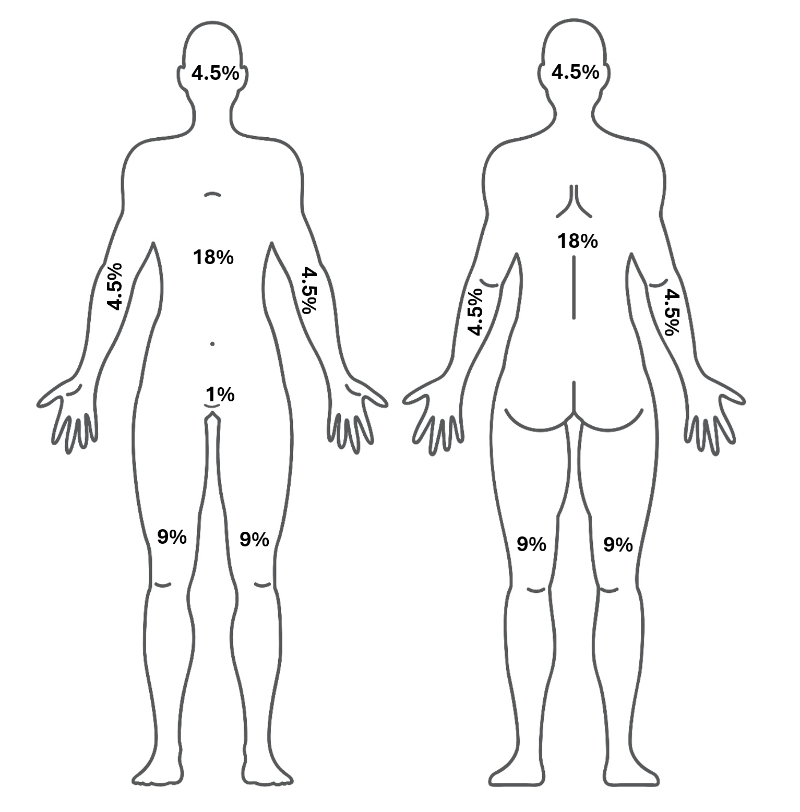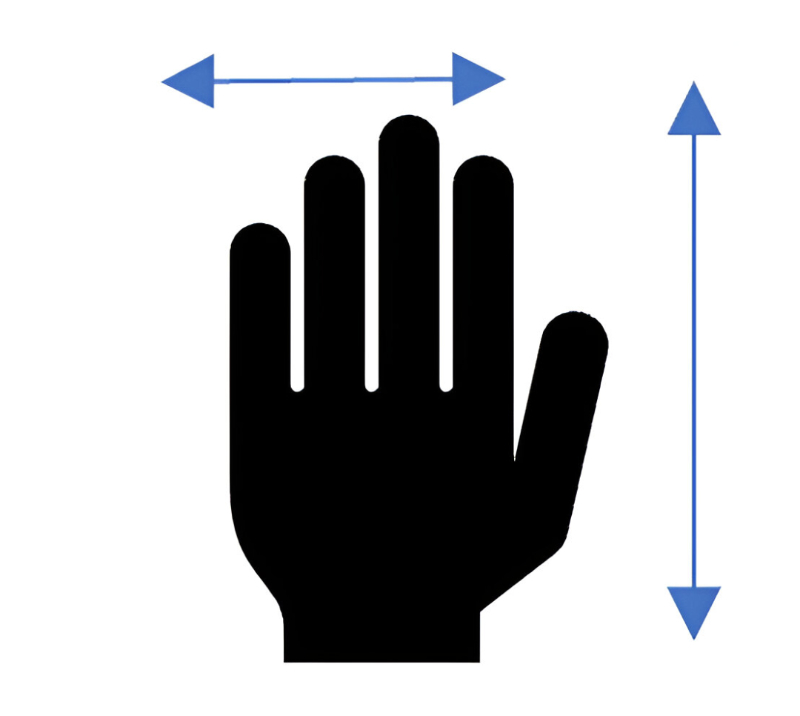| Petrolatum impregnated (e.g., Vaseline®) gauze covered with a second dry normal gauze layer secured by netting or tape. | Superficial partial-thickness burn wounds and deep dermal partial-thickness burns with scant to light exudate. | - Conforms to body contours
- Maintains a moist wound environment
- Non-traumatic dressing changes
| - Not antimicrobial
- Must be secured with a secondary dressing
- Not meant for highly exudating wounds
|
| Silicone-coated nylon dressings (with and without foam layer): soft silicone porous layer (Safetac®), which is transparent and flexible polyamide mesh (examples: Adaptic Touch® silicone dressing; Allevyn®; Biatain®); Equos 5-layer square with silicone adhesive (or Veratel® contact layer silicone wound dressing), Mepitel (fenestrated, thin, transparent porous and flexible polyamide mesh); Mepilex border wound dressing (polyurethane foam dressing with a Safetac® silicone contact layer and gently adherent border); Mepilex Ag (includes silver), etc. | Superficial partial-thickness burn wounds and deep dermal partial-thickness burns with light to moderate exudate (dependent on the ability of absorptive materials in specific silicone dressings).
Some of these silicone sheets may also be used for status-post burns on healing skin to help prevent hypertrophic scarring (keloids). | - These are low-adherent dressings, meaning they may be applied and removed without trauma to the open wound or wound bed. Often, a combined product that contains several layers, with the contact layer being a fenestrated silicone layer. Often used with foams and other products.
- Usually soothing and may help reduce pain.
- May or may not contain antimicrobial agents such as silver.
- Most may be left in the wound for several days (e.g., 3-7 days).
| - Note: Adaptic Touch is a silicone dressing, but Adaptic non-adhering dressing does not contain silicone; it is a knitted cellulose acetate mesh fabric impregnated with a petrolatum emulsion.
- Some of these products may need some added protective measures to protect periwound skin in exudating wounds to prevent maceration.
|
Polymeric hydrogel dressings:
High water content (70-90%) gel dressing as a gel in a tube or as a flexible sheet, pad, or gel rope (e.g., Elastogel® sheets or pads, IntraSite®, Aqua clear®, Nu-gel®, Medagel®, etc.).
May also be impregnated or in a combined product with silver (e.g., SilverSeal®, SilverSept®, etc.), or other antimicrobial.
Hydrogels tend to be non-irritating and are metabolite-permeable. | Second-degree burns, some third-degree burns. Partial-thickness to full-thickness burns.
Also, may be used on split-thickness skin donor sites.
May also be used for status-post burns on healing skin to help prevent hypertrophic scarring (keloids).
Suitable for all phases of wound healing and both acute and chronic wounds.
| - Maintains moist wound environment.
- Will not dry out. In some cases, may absorb up to 10 times its weight in exudate.
- May facilitate autolytic debridement.
- These dressings may be left in place for several days (1-7 days), depending on the product and the amount of exudate.
- They are flexible, conforming to the body.
- They typically provide non-traumatic dressing changes (easy to remove).
- Benefits both granulation tissue and epithelium.
- Usually soothing and/or cooling and may reduce pain.
- Some gel sheets are also recommended to prevent or reduce hypertrophic scarring.
| - May require secondary dressing.
- In highly exudating wounds, especially if moisture is excessive and not well-managed, and periwound skin is not protected, they may be associated with periwound maceration.
- In the amorphous gels, there is a lack of bulk to fill cavernous wounds (may need to be combined with appropriate wound filler dressing material).
- Some gel sheets may come with an adhesive border, but many gel sheets do not and must be secured with a secondary dressing.
|
Hydrofiber dressings:
Typically made up primarily of sodium carboxymethyl cellulose. This fiber essentially turns into a gel when moistened or in contact with wound exudate. (Example: Aquacel®).
May be impregnated with ionic silver as an antimicrobial dressing (Aquacel Ag® and Aquacel Ag® Burn Hydrofiber dressing).
| Second-degree burns, some third-degree burns. Partial-thickness to full-thickness burns.
Also may be used on split-thickness skin donor sites.
Suitable for all phases of wound healing and both acute and chronic wounds.
| - Can potentially absorb up to 25 times their initial weight (highly absorbent), making them a good choice for exudating wounds.
- Helps maintain a moist wound bed when pre-moistened.
- The fiber conforms to the wound bed and typically is non-traumatic when removed.
- Easy to use.
| - If moisture is not managed in highly exudating wounds and/or periwound skin is not protected, you may see peri-wound maceration.
- These dressings should typically be applied to open partial-thickness or full-thickness wounds, not intact peri-wound skin.
- Usually requires a secondary dressing.
|
| Hydrocolloid dressings (pads): Occlusive dressing that provides a moist wound environment. As the inner layer of the dressing comes into contact with exudate, a gel forms. | Superficial and deep dermal partial-thickness burns with scant to light exudate. | - Flexible.
- May provide some padding (protection from friction).
- Keeps small dermal burn wounds covered and may provide some pain relief. May assist with autolytic debridement.
- Self-adherent pads do not require secondary dressings.
| - Meant to be left in place for several days, however, it may be too sticky for some painful burns.
- If used over intact blisters, the roofs of the blisters may be opened upon attempts to remove this dressing due to adherent properties.
- Dressing changes may be painful if tightly adhered to fragile tissue.
- May not be appropriate for highly exudating wounds.
|
| Polyurethane film (polymer membranes) dressings: Typically, these transparent film dressings are coated with an adhesive on one side. These dressings are made in different thicknesses and are usually gas permeable (allows oxygen and moisture vapor transmission) but not permeable to liquid and environmental contaminants such as bacteria. | Suitable for second-degree burns, partial-thickness wounds with little or no exudate, and necrotic wounds (when autolytic debridement is desired).
Also used to cover IV sites, donor sites, lacerations, and abrasions. | - Allows visualization of the wound.
- May be used as a primary or secondary dressing.
- Available in a wide variety of sizes, both sterile and nonsterile.
- May promote autolytic debridement.
| - Not recommended for moderate or heavy exudates.
- Not recommended for infected wounds.
- Only apply to wounds if the skin is intact and the film is large enough to cover the entire wound with enough periwound skin to adhere to.
- May cause maceration.
- Not for use on fragile or friable skin.
- May be dislodged in high-friction locations on the body.
|
| Medicated wound dressings, gels, and ointments: These include various dressings, gels, and ointments that contain medications (some of which are specifically antimicrobial) to stimulate healing, assist with debridement, or help address wound healing impediments such as biofilm growth (e.g., surfactant wound care products). As far as the use of antimicrobials in burn wound care, it is important to note that a recent systematic review reports “it is necessary to emphasize that there is currently no ideal topical antimicrobial agent that can be recommended in all clinical scenarios” (Garcia Garcia et al., 2022). |
1% Silver sulphadiazine cream (SSD) (e.g. Silvadene®). This has been prescribed for more than 50 years, but there is some evidence to suggest some newer products may promote healing faster than SSD.
Typically requires a secondary dressing. | Open superficial and deep dermal partial-thickness and some full-thickness wounds (second- and third-degree wounds). Often used to cover wounds.
Please note: SDD is contraindicated in pregnant women close to term and in premature and newborn infants in the first two months of life. | - Antimicrobial. Thought to have a broad spectrum, acting against Staphylococcus aureus and Pseudomonas aeruginosa.
| - Requires once or twice daily application.
- Difficult to remove completely during cleansing, thus may be difficult to assess subtle changes in wound bed.
- Not recommended to use more than seven days (prolonged use increases risk of hypergranulation in full-thickness wounds).
- Persons sensitive to sulfa medications (sulfonamides) may demonstrate sensitivity to SSD.
- Side effects may include pain, burning sensation, and itchy skin. In some cases, use over large surface areas may cause temporary neutropenia.
- Do not combine with collagenase ointment, cadexomer iodine products, or other silver dressings.
|
Collagenase ointment (enzymatic debriding agent) (Example: Santyl®).
One of the only FDA-approved enzymatic debriding ointments (approved for adults). | Suitable for second-degree burns, partial- and full-thickness burns with necrotic tissue in wound bed. | - Offers gentle debridement by enzymatic activity.
- There are a few silver products that collagenase ointment may be combined with, such as:
- Actisorb®, Algicell®, Algidex Ag®, Allevynn Ag®, AQUACEL Ag®, AQUACEL Ag Extra®, Argentyn 23®, Biatain Ag®, Calcium Alginate Dressing with Silver®, Durafiber Ag®, EltaMD SilverGel®, ExcelGinate Ag®, KerraCel Ag®, Maxorb Extra Ag+®, Mepilex Ag®, Optifoam Ag®, PolyMem Ag®, Restore Calcium Alginate®, Restore TRIACT Silver®, SilvaKollagen Gel®, SILVERCEL®, SilverMed®, Sorbalgon Ag®, TRITEC Ag®.
| - Typically needs to be applied once a day.
- There are many wound products, antimicrobials (especially silver), and wound cleansers with which collagenase ointment should not be used with/combined with (please click here for complete lists).
- DO NOT use collagenase ointment in the same wound at the same time as cadexomer Iodine products.
- DO NOT use collagenase ointment in the same wound at the same time with these silver products:
- ACTICOAT®, Arglaes silver alginate powde®r, Biostep®, ColActive Plus Ag®, DermaGinate/Ag®, Gentell AG®, KerraContact Ag®, Melgisorb®, Normigel Ag®, NovaGran Blue®, Opticell Ag+®, Puracol Plus Ag+®, Resta SilverGel®, Silvadene®, SilvaSorb®, Silverce®l, SilverGel®, Silverlon®, Tegaderm Ag®, Therabond 3D®.
|
Nanocrystalline silver (NCS) in a flexible sheet or pad (such as Acticoat®, Acticoat Flex®, and Acticoat® surgical dressings).
Antimicrobial (bactericidal) against over 150 organisms, including methicillin-resistant Staphylococcus aureus (MRSA), vancomycin-resistant Enterococcus (VRE), carbapenem-resistant Enterobacterales (CRE), gram-negative and gram-positive bacteria, yeasts, and fungi. | Second-degree burns, some third-degree burns (partial-thickness to full-thickness burns) with signs and symptoms of local wound infection and/or at high risk of wound infection.
Also may be used on split-thickness skin donor sites.
Suitable for all phases of wound healing and both acute and chronic wounds.
Expect to see decreased signs and symptoms of infection within two weeks. | - Starts antimicrobial action within 30 minutes of being applied to wound.
- Most of these products may be left in the wound for up to seven days, depending on exudate management requirements.
- Surgical dressings may be applied by the surgeon after surgical closure.
| - Do not combine with iodine products in the wound.
- Do not combine with collagenase ointment.
- Not typically recommended for applying to the face, as silver may stain tissues.
|
| Cadexomer Iodine, containing wound gels or pads (such as Iodosorb®), is a water-soluble modified starch polymer containing 0.9% iodine (available over-the-counter). | Second-degree burns, some third-degree burns (partial-thickness to full-thickness burns) with signs and symptoms of local wound infection and/or at high risk of wound infection.
Also may be used on split-thickness skin donor sites.
Suitable for all phases of wound healing and both acute and chronic wounds.
Expect to see decreased signs and symptoms of infection within two weeks. | - Antimicrobial against gram-negative bacteria, gram-positive bacteria (MRSA, VRE, Pseudomonas),fungi, and yeast.
- May be left in place up to three days (color changes from dark brown to white/grey as the iodine is used up).
| - Do not use in those sensitive or allergic to iodine.
- Might not be appropriate for people with thyroid disease.
- Not recommended for use during pregnancy or breastfeeding.
- Do not combine with NCS dressings such as Acticoat.
- Do not combine with collagenase ointment.
|
| 3% Bismuth Tribromophenate and petrolatum impregnated gauze (e.g., Xeroform®), typically covered with a second dry normal gauze layer secured by netting or tape. | Superficial and deep dermal partial-thickness burns with scant to light exudate. | - Bacteriostatic (discourages bacterial growth but does not kill it) action on lightly exudating wounds.
- Conforms to body contours.
- Maintains moist wound environment.
- Typically, non-traumatic dressing changes.
| - Must be secured with secondary dressing.
- Do not combine with collagenase ointment.
|
| Polyhexamethylene biguanide (PHMB) (typically 0.2% to 1%) impregnated gauze and wound dressing materials. Examples include AMD Gauze®, PuraPly®, and PuraPly AM® (cross-linked ECM in the form of a collagen sheet impregnated with 1% PHMB). | Second-degree burns, some third-degree burns (partial-thickness to full-thickness burns) with high bioburden signs and symptoms of local wound infection, and/or at high risk of infection.
Also may be used on split-thickness skin donor sites.
Suitable for all phases of wound healing and both acute and chronic wounds.
Expect to see decreased signs and symptoms of infection within two weeks. | - Antimicrobial against gram-negative bacteria, gram-positive bacteria (MRSA, VRE, Pseudomonas), fungi, and yeast.
- May be left in place up to three days.
- AMD gauze comes in sponges, packing ribbons, and rolls.
- May be used on all ages.
- It is sometimes used with negative pressure wound therapy.
| - Do not use in persons with known sensitivity or allergy to PHMB.
- Do not use along with sprays, ointments, creams, powders, or petrolatum-based dressings, such as Vaseline Gauze, Adaptic, and Xeroform (creates a barrier and prevents the bacteria-killing effects of PHMB).
- Do not use with Dakin’s Solution (sodium hypochlorite solutions) - these solutions will deactivate PHMB.
|
| (Bhoyar et al., 2023; Cook et al., 2022; Nedelec, et al., 2015; Radzikowska-Büchner et al., 2023) |











